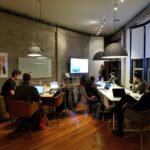Decoding Peer Learning Dynamics to Enhance Mentorship Frameworks in Offshore Software Development
Understanding the Role of Peer Learning in Offshore Software Development
Why Peer Learning Matters in Distributed Teams
Peer learning—where team members grow by sharing knowledge and experiences—is increasingly important in offshore software development. In globally distributed teams, where developers work across time zones and cultural contexts, peer learning helps bridge knowledge gaps and fosters stronger team cohesion.
Unlike traditional top-down mentorship, peer learning supports mutual development. Junior developers gain hands-on insights from experienced colleagues, while senior developers sharpen their leadership and communication skills. This reciprocal learning model is especially useful in offshore teams, where time differences and limited face-to-face interaction can make formal mentorship more challenging.
In regions like Vietnam, Poland, and the Philippines—where offshore software development is rapidly growing—peer learning is often embedded in team culture. These countries emphasize collaboration and shared growth, which contributes to their reputation for delivering technically strong and adaptable development teams.
How Peer Learning Enhances Mentorship Frameworks
Offshore mentorship programs often face hurdles such as asynchronous communication, cultural nuances, and limited direct engagement. Peer learning can help fill these gaps by creating informal support networks that complement formal mentorship structures.
Simple practices like buddy systems or rotating code review partners can foster continuous learning and feedback. These peer-driven approaches help reinforce mentorship goals while distributing the responsibility more evenly across the team.
Peer learning also encourages psychological safety—developers feel more comfortable asking questions and sharing ideas without fear of judgment. This is especially valuable for new team members who may be hesitant to reach out to mentors in other time zones or countries.
By weaving peer learning into mentorship frameworks, offshore teams can build a more adaptive and supportive learning environment. This not only accelerates skill development but also contributes to higher retention and job satisfaction.
What Makes Peer Learning Effective in Offshore Teams?
Key Elements of a Successful Peer Learning Culture
Effective peer learning in offshore teams doesn’t happen by accident—it requires thoughtful planning. It begins with creating a culture where sharing knowledge is encouraged and valued.
Leaders play a key role in setting the tone. When team leads and senior developers actively participate in peer learning, it signals that collaboration is a priority. This is especially impactful in multicultural teams, where norms around communication and hierarchy can vary.
Structured opportunities for interaction are also essential. Activities like virtual stand-ups, pair programming, and internal knowledge-sharing sessions can help build trust and reduce isolation among team members.
Technology can support this process. Tools like shared documentation platforms, asynchronous video updates, and chat-based Q&A channels make it easier for team members to learn from each other, regardless of location or time zone.
Real-World Practices from Leading Offshore Development Hubs
Offshore development teams in countries such as Vietnam, Ukraine, and Mexico have adopted various peer learning strategies that enhance both mentorship and collaboration.
In Vietnam, for example, some teams rotate mentorship responsibilities among mid-level developers, allowing them to guide juniors on specific projects. This approach not only shares the mentorship load but also helps cultivate leadership skills across the team.
Ukrainian teams often organize internal hackathons and coding challenges to promote peer learning. These events encourage cross-functional teamwork and provide a platform for developers to share their expertise in a hands-on way.
In Mexico, some companies run “learning sprints,” where developers explore new technologies together and present their findings. This practice keeps teams aligned with industry trends and fosters a culture of continuous learning.
These examples show how peer learning can be adapted to different cultural and organizational contexts, making it a flexible and effective tool for strengthening mentorship in offshore development teams.
What’s Next? Building a Peer Learning Strategy for Your Offshore Team
Steps to Integrate Peer Learning into Your Mentorship Framework
If you’re looking to incorporate peer learning into your offshore mentorship approach, start by evaluating your current team dynamics. Look for existing informal learning habits that could be formalized or expanded.
Set clear goals—whether you’re aiming to improve onboarding, speed up skill development, or encourage cross-team collaboration. These goals will help shape your strategy and measure its impact.
Design structured opportunities for peer interaction, such as mentorship circles, scheduled pair programming, or regular knowledge-sharing sessions. Make space for these activities during work hours and recognize contributions to keep engagement high.
Finally, collect feedback and iterate. Offshore teams evolve, and your peer learning strategy should evolve with them. Stay flexible and responsive to team needs, project demands, and cultural factors.
By thoughtfully integrating peer learning into your mentorship framework, you can build a more collaborative, resilient, and high-performing offshore software development team.




